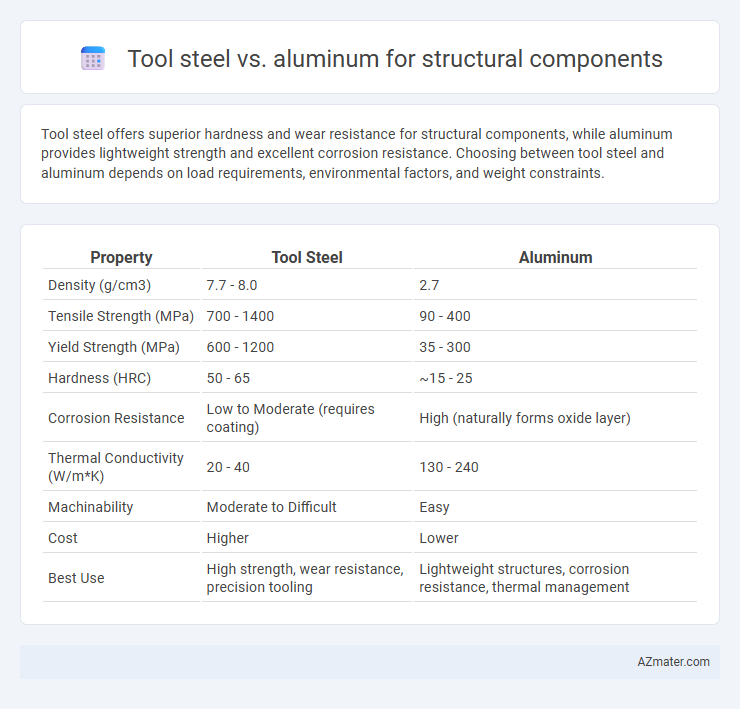Tool steel offers superior hardness and wear resistance for structural components, while aluminum provides lightweight strength and excellent corrosion resistance. Choosing between tool steel and aluminum depends on load requirements, environmental factors, and weight constraints.
Table of Comparison
| Property | Tool Steel | Aluminum |
|---|---|---|
| Density (g/cm3) | 7.7 - 8.0 | 2.7 |
| Tensile Strength (MPa) | 700 - 1400 | 90 - 400 |
| Yield Strength (MPa) | 600 - 1200 | 35 - 300 |
| Hardness (HRC) | 50 - 65 | ~15 - 25 |
| Corrosion Resistance | Low to Moderate (requires coating) | High (naturally forms oxide layer) |
| Thermal Conductivity (W/m*K) | 20 - 40 | 130 - 240 |
| Machinability | Moderate to Difficult | Easy |
| Cost | Higher | Lower |
| Best Use | High strength, wear resistance, precision tooling | Lightweight structures, corrosion resistance, thermal management |
Introduction: Tool Steel vs Aluminum for Structural Components
Tool steel offers exceptional hardness, wear resistance, and high tensile strength, making it ideal for heavy-duty structural components subjected to intense mechanical stress. Aluminum provides a lightweight alternative with excellent corrosion resistance and good strength-to-weight ratio, suitable for applications where weight reduction is critical. Selecting between tool steel and aluminum depends on the specific structural requirements, including load-bearing capacity, environmental exposure, and fabrication constraints.
Material Properties Comparison
Tool steel offers superior hardness and wear resistance compared to aluminum, making it ideal for high-stress structural components prone to abrasive environments. Aluminum excels in lightweight applications due to its low density, providing excellent corrosion resistance and good tensile strength but lower fatigue resistance than tool steel. The choice between tool steel and aluminum depends on balancing the need for durability and strength against weight reduction and corrosion performance in specific structural designs.
Strength and Durability
Tool steel offers superior strength and durability compared to aluminum, making it ideal for high-stress structural components. Its high tensile strength and wear resistance enable prolonged performance under heavy loads and harsh conditions. Aluminum, while lighter and corrosion-resistant, typically lacks the hardness and fatigue endurance required for demanding structural applications.
Weight Considerations
Tool steel is significantly denser than aluminum, approximately 7.85 g/cm3 compared to aluminum's 2.70 g/cm3, making steel components much heavier for the same volume. The higher weight of tool steel can increase the overall mass of structural components, impacting fuel efficiency and ease of handling in applications such as automotive or aerospace engineering. Aluminum offers a superior strength-to-weight ratio, making it the preferred choice where reducing weight without sacrificing structural integrity is critical.
Corrosion Resistance
Tool steel offers superior strength and wear resistance but is more susceptible to corrosion compared to aluminum, especially in humid or marine environments. Aluminum exhibits excellent corrosion resistance due to its natural oxide layer, making it ideal for structural components exposed to moisture. Choosing aluminum for structural applications enhances durability and reduces maintenance in corrosive conditions.
Machinability and Fabrication
Tool steel offers superior strength and wear resistance compared to aluminum, but it presents greater challenges in machinability due to its hardness, often requiring specialized cutting tools and slower machining speeds. Aluminum excels in ease of fabrication and machinability, allowing faster machining cycles and reduced tool wear, which is beneficial for complex or high-volume structural components. While aluminum is lightweight and corrosion-resistant, tool steel's durability makes it preferable for applications demanding higher load-bearing capacity and long-term structural integrity.
Cost Efficiency
Tool steel offers superior strength and wear resistance for structural components but at a significantly higher material and machining cost compared to aluminum. Aluminum provides a cost-efficient alternative due to its lower material price, ease of fabrication, and lighter weight, which can reduce transportation and installation expenses. For projects prioritizing budget and weight reduction without extreme durability requirements, aluminum often delivers better overall cost efficiency.
Suitability for Various Applications
Tool steel offers superior strength, hardness, and wear resistance, making it highly suitable for heavy-duty structural components subjected to high stress and abrasive conditions. Aluminum provides excellent corrosion resistance, lightweight advantages, and good machinability, ideal for applications where weight reduction and moderate strength are critical, such as aerospace and automotive structures. Selecting between tool steel and aluminum depends on specific performance requirements, environmental exposure, and load-bearing demands of the application.
Environmental Impact and Sustainability
Tool steel offers higher durability and longer lifespan compared to aluminum, reducing the need for frequent replacements and minimizing resource consumption. Aluminum, although lightweight and energy-efficient during transportation, has a more energy-intensive extraction and recycling process, impacting overall sustainability. Choosing between tool steel and aluminum requires balancing environmental impact with structural performance and application-specific requirements.
Conclusion: Choosing the Optimal Material
Tool steel offers superior hardness, wear resistance, and strength, making it ideal for high-stress structural components requiring exceptional durability. Aluminum provides advantages in weight reduction, corrosion resistance, and ease of fabrication, benefiting applications where lightweight and corrosion protection are critical. Selecting the optimal material depends on balancing performance requirements, environmental conditions, and cost considerations specific to the structural application.

Infographic: Tool steel vs Aluminum for Structural component
 azmater.com
azmater.com